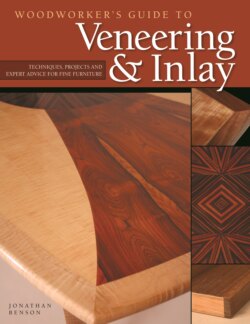Читать книгу Woodworker's Guide to Veneering & Inlay (SC) - Jonathan Benson - Страница 20
На сайте Литреса книга снята с продажи.
Flat Slicing
ОглавлениеIn flat slicing, the log is held stationary with respect to the knife, which advances into the log by the thickness of each successive leaf. Most veneer slicing machines have a stationary knife. A heavy apparatus grips the log, moving it up and down against the cutting edge. Flat-sliced veneers can be crown cut, quarter sliced, or quartered and then flat sliced.
Plain Slicing (Flat Slicing)
Plain slicing is the most common method for producing flitch-cut veneers. It produces exactly matched consecutive sheets of veneer with a grain pattern resembling a flat-sawn board. The pattern will change slightly as the knife moves deeper into the log. If the edges are not clipped, some sheets will have uneven edges or will contain sapwood, which can be used to create interesting contrasts in color.
Quarter Slicing
Quarter-slicing will produce exactly matched quarter-sawn sheets with a strong linear pattern. It can also emphasize mottled figure in some woods. The quartered logs also can be rotated 90° to slice the veneer starting from the outside of the trunk, tangential to the curve of the annual rings. This will maximize the yield of quilted figure, which usually appears only near the surface of the log.
Lengthwise Slicing
Slicing lengthwise can produce a variety of grain patterns depending on the orientation of the log to the knife, the same as plain and quarter slicing. The difference is in the type of equipment. Lengthwise slicing is similar to the method you would use if you were to saw your own veneer, as detailed in Chapter 11.
